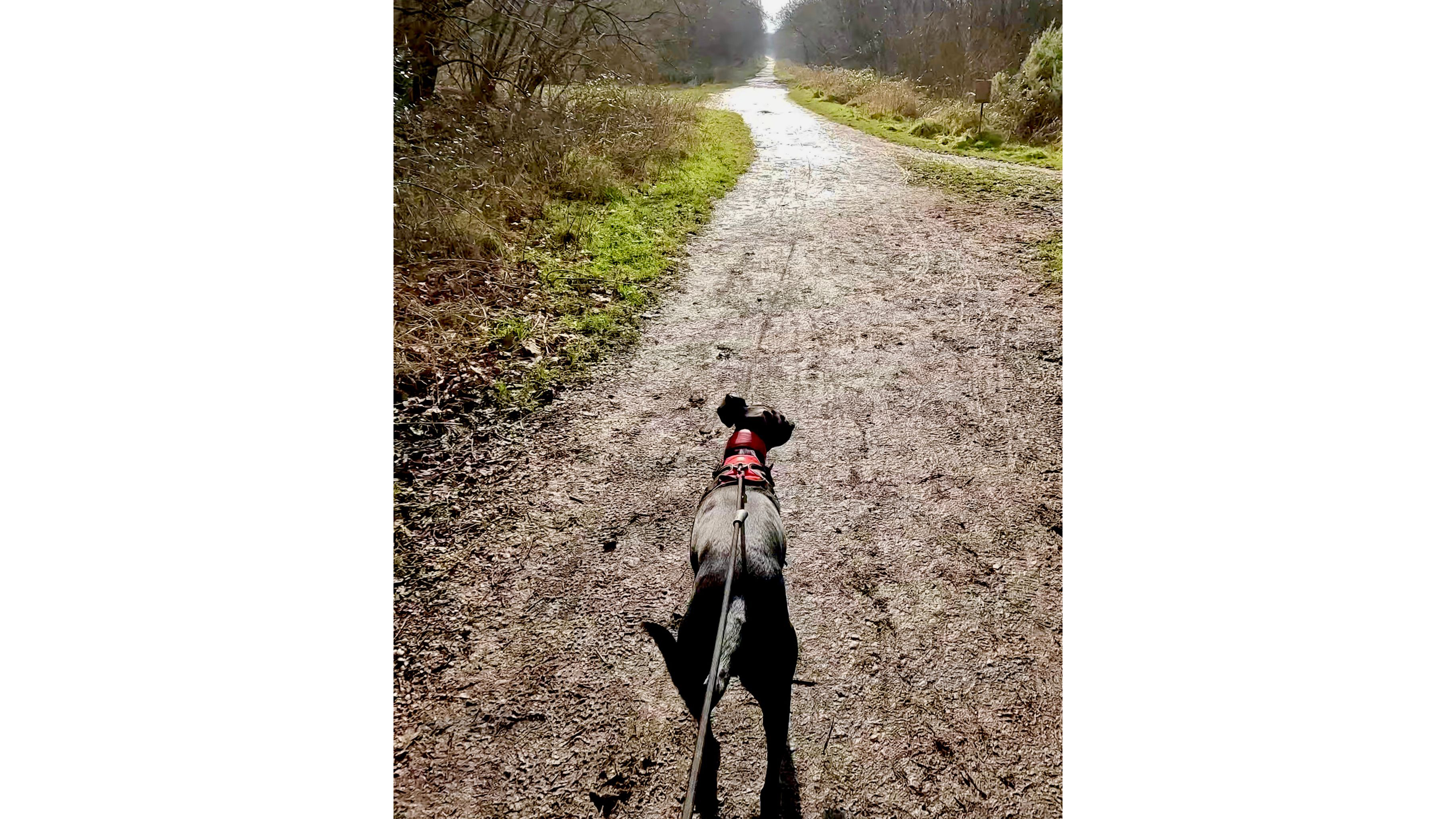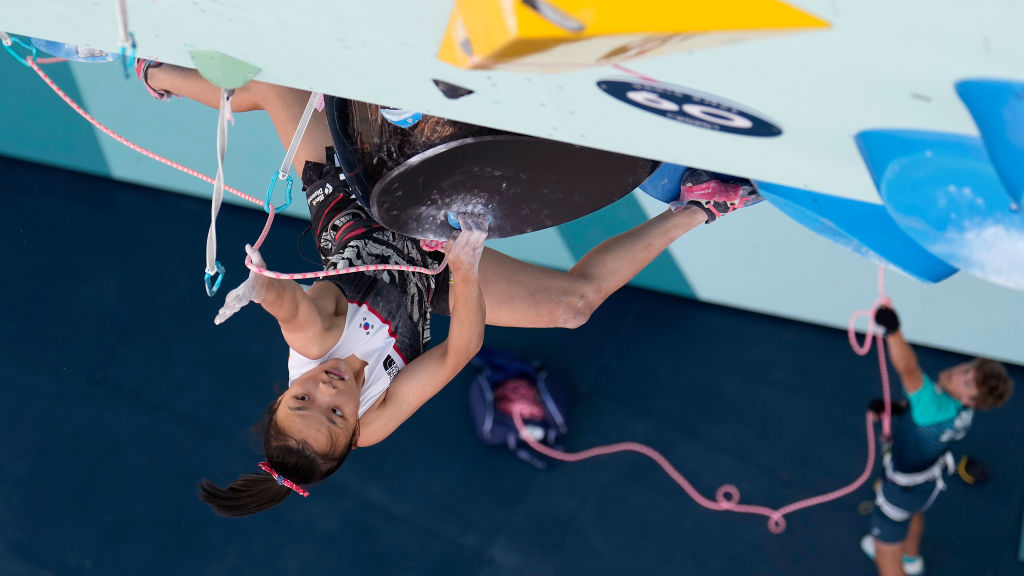Who let the dogs out: how to start (and how not to start) canicross running
What happened when I started trail running with my four-legged friend, Finley

I have a dog who loves to run. I mean, really loves to run. He doesn’t need a ball to chase, a frisbee to catch or a fox to pursue, he runs purely for the fun of it. And we’re not talking about gentle ambling here – we’re talking Usain Bolt levels of speed.
Show Finley – a greyhound-cockerspaniel cross – an Olympic 100m sprint final and I reckon he'd show Bolt a clean pair of heels on the way to smashing his world record in half. This little chap flies – and he does it all with pure joy etched all over his soppy little face.
His running prowess isn't confined to sprint distances, either. Finley has a tracker that allows us not only to follow his movements when he’s off the lead, galloping with abandon through the Great British countryside, but also to record the mileage he accumulates while doing so.
A few weeks ago I went on a 10-mile fell run with Finley. Well, I did 10 miles… During the two hours or so that this run took me, Finley had casually knocked out a 31 mile (50km) ultra marathon. Yes, my dog is either completely bonkers or a physiological freak of nature.
This got me thinking. Other than keeping us entertained with his unbridled zeal and predilection for a damn good snuggle on the couch, Finley’s character could be employed for a greater good – namely to make me the fastest runner in Berkshire. Yes, I would quite literally harness his power and use Finley as my own personal locomotive.
I am of course talking about canicross, a relatively new athletic endeavor in which dog and owner run together with a view to the canine in question giving his human a helpful tow.
Here’s what I learned when Finley and I embarked on this new adventure...
All the latest inspiration, tips and guides to help you plan your next Advnture!
Equipment
I researched the equipment and canicross basics. Finley is quite a small dog so a snug well-fitting harness was required. There are a huge amount of these products to wade through but we eventually found a good robust item that wouldn’t cause any chafing while he was powering us along on our (hopefully) record-setting runs.
Next on the list was a stretchy bungee lead. In order to mitigate the chances of Finley and I herniating a disc, a good medium-sized lead – some 12ft (2m) under tension – is a really important piece of canicross equipment. It also allows your dog a slightly greater sense of freedom, with a bungee lead somewhat less restrictive than a standard one.
The last piece of kit on the list was a waist belt for myself. Again, there are a heap of options to choose from and the more you spend the better the longevity is likely to be and the more features you get. I’ll admit to scrimping slightly here – a Three Peaks belt with a secured zip pocket is big enough for my phone and keys, while an open pocket accommodates a handful of treats and the inevitable poop bags.
Getting started
The internet is awash with canicrossing social groups. It was amazing to find so many runners who had not only taken up running with their dogs, but had also gone as far as to enter organised races. While canicross exclusive events are still fairly scarce, there’s a big number of running races that will allow canicrossers to take part too. It’s also very common to see dogs at parkruns, although there’s often a stipulation that prevents owners from using belts and bungee leads.
Before joining any sanctioned events, though, I decided it wise to give my equipment – and my dog – a test ride. Finley was super keen to get into his new harness. In fact Finley is super keen to do anything – and the prospect of ‘walkies’ combined with a shiny new harness set his tail off on such as frenzied bout of wagging that he pretty much levitated out of the door.
I was equally excited. Finley’s energy would be the start of a new and improved me – we’d reach the dizzy heights of five minute miles. Today would be the day that I (well, we) would find out what it was like to run a sub-20 minute 5km. Hell, we might even beat the canicross 5km world record which before our run is believed to stand at 12 minutes 24 seconds (spoiler: it still does).

Where to run
Trails in the UK haven’t been at their best lately. Bridleways have been bashed up by horses and mountain bikes; footpaths have been damaged by a thousand wellington boots. We wouldn’t be staying upright on these, let alone breaking world records, so I drove us to an old quarry site with tracks comprising hardpacked gravel. This would be the perfect proving ground for me and my pet.
With the harness now clicked into place, the lead carabiners secured and the waist belt firmly strapped on, I braced myself: “Finley,” I said. “I feel the need. The need for speed.”
The quest for speed
I’d like to have said at this point we zoomed off into the horizon at breathtaking speeds. But this did not happen. We just stood there staring expectantly at one another.
I started to jog. Finley followed beside me at heel. This was literally the first time he’s ever trotted loyally by my side. Was there a power switch on the harness I hadn’t read about in the instructions? His lack of urgency and our lack of speed continued as we negotiated the network of gravel tracks two abreast. It was all rather disappointing. I’d gone from Mo Farah to Moe from The Simpsons in less than 60 seconds.
It was time to seek assistance and advice from someone with a little more experience in the sport. Brian Slack, who set up the North Downs Canicrossers, has been running with his dalmatian and German short-haired pointer for eight years and was happy to tell me why we hadn’t got off to the flying start I’d envisioned.
“I would say most dogs won't run with individuals, but as soon as they get into a pack they have that pack mentality and will become quite competitive,” Brian explained.
“They don't want to be left behind. And you'll find that with a lot of dogs that come out they tend to be a lot more focussed on the running when there's a group of dogs.”

This, then, made absolute sense. Finley had no incentive to run with his human. He either wants to be gallivanting around the woods seeking out smells or running in a pack with at least one other dog.
I fetched Luna, our eight-year-old labrador-lurcher cross and headed out for round two. Would the presence of Finley’s sister elicit a more dynamic outing?
I didn’t have to wait long for an answer. No sooner had we stepped out of the car door than Finley took off at breakneck speed – he simply wanted to run. Luna and I were now passengers on the Finley Express – a tumult of dust and rubble in our wake.
But regardless of the speed at which you travel, there’s little that can compare with a few hours on the trails with one’s hound. Dogs are great companions, they love being outside, and more than anything they love being with you.
As canicrosser Peter Graham says: “Canicross is more than just running with your dog – it’s a shared adventure that strengthens your bond, fuels your fitness, and brings pure joy to both dogs and people. All you need is a harness, a trail and a spirit for fun. Lace up, leash up, and let the journey begin!”
